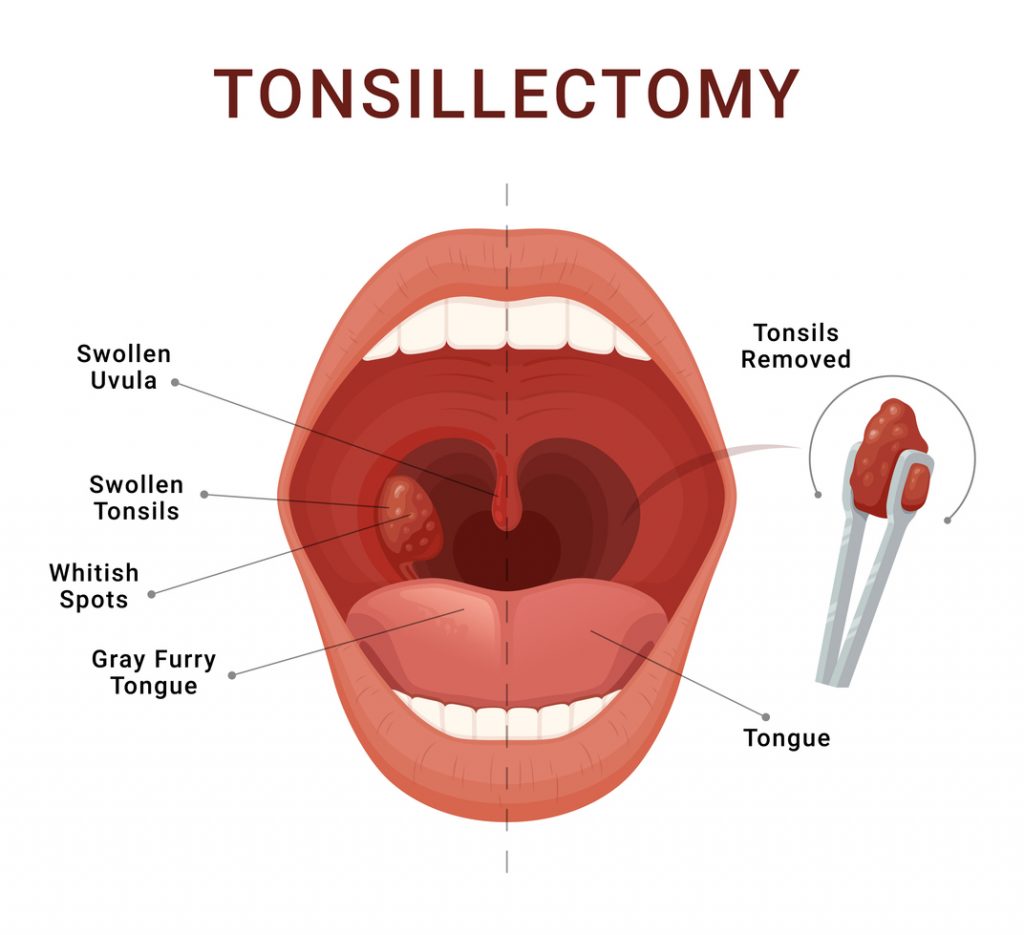As a parent, you want the best for your little one. But sometimes, it’s hard to tell if those pesky tonsils or adenoids are causing more harm than good. If your child’s been dealing with persistent sore throats, severe snoring, or frequent ear infections, it might be time to consider removal. Read on to learn the top signs that your child’s tonsils or adenoids may need to go.
What are tonsils and adenoids?
Tonsils and adenoids are part of the immune system, made up of lymphoid tissue located in the back of the throat and the upper part of the throat behind the nose, respectively. Tonsils, which are two oval-shaped pads, sit on each side of the throat, while the adenoids are a single mass of tissue situated high in the throat behind the nasal airways. Both work to capture bacteria and viruses that enter the body through the mouth and nose.
It’s important to understand that removing the tonsils and adenoids does not negatively impact the overall functionality of the immune system. Studies have shown that children who have their tonsils and adenoids removed do not have a higher risk of infections compared to those who keep these tissues. The immune system adapts and continues to function effectively even without tonsils and adenoids.
Signs and symptoms that removal might be necessary
It’s natural to feel concerned when your child needs to undergo a surgical procedure. When it comes to removing tonsils and adenoids, it’s important to understand the reasons behind this decision and the potential health benefits it can provide.
- Recurrent infections: One of the most common reasons for considering tonsil and adenoid removal in children is recurrent infections. If your child is experiencing multiple cases of strep throat or tonsillitis in a year, despite antibiotic treatment, it may be time to consider surgery. Chronic infections can not only be painful for your child but can also lead to complications if left untreated.
- Obstructive sleep apnea: Another reason to consider removing your child’s tonsils and adenoids is if they are experiencing obstructive sleep apnea. Enlarged tonsils and adenoids can obstruct the airway during sleep, leading to breathing difficulties, snoring, and poor sleep quality. If left untreated, obstructive sleep apnea can have long-term effects on your child’s health and development.
- Difficulty swallowing or breathing: If your child is having difficulty swallowing food or liquids, or if they are struggling to breathe due to enlarged tonsils and adenoids, it may be necessary to consider surgery. These issues can impact your child’s ability to eat properly and get enough oxygen, which can affect their overall health and well-being.
- Persistent symptoms despite treatment: If your child has been experiencing persistent symptoms related to their tonsils and adenoids, such as chronic sore throats or ear infections, despite trying various treatments like antibiotics or allergy medications, surgery may be the next step. Working closely with your child’s healthcare provider is essential to determine the best course of action for their specific condition.
If you’re nodding your head to any of these, it’s time to schedule a consultation with the ENT specialists at Oakdale ENT Clinic. We can help you weigh the pros and cons and determine if removal is the right call.
Tonsillectomy and adenoidectomy
Tonsillectomy or adenoidectomy is a common procedure that can make a world of difference in your child’s quality of life. The procedure itself is typically done in the operating room under general anesthesia, ensuring your child is asleep and comfortable throughout the procedure. Our anesthesiology team meticulously monitors your child’s well-being, ensuring their safety and comfort at all times. Our surgeon will remove the tonsils and adenoids through the mouth, avoiding any external incisions and thereby leaving no scars. The entire procedure normally takes less than an hour; in most cases, your little one can be back home with you the same day.

Recovery process and care
It’s normal for children to experience some pain, swelling, and discomfort in the throat and ears during the first few days after the procedure. With the right care and support, you can make the recovery process much smoother. Here are some practical tips to keep in mind:
- Encourage your child to prioritize rest in the days after their surgery, steering clear of any vigorous activities to allow ample time for recovery.
- Address pain and discomfort using the medications prescribed by our team. For managing post-surgical pain, acetaminophen and ibuprofen are commonly recommended.
- Provide your child with soft, easy-to-swallow nourishment such as mashed potatoes, yogurt, and smoothies. Steer clear of spicy, crunchy, or acidic foods that could aggravate the throat.
- Ensure your child stays well-hydrated by promoting the consumption of ample water, juice, and other clear fluids. Adequate hydration is crucial for preventing complications and fostering a swift recovery.
- Always reach out to Oakdale ENT with any concerns regarding the recovery process. We’re here to support both you and your child every step of the way.
Next steps
Your child deserves to breathe comfortably and be at their best. If enlarged tonsils or adenoids are hindering them, considering this routine procedure might be a wise choice. Get in touch with us to learn more, and we’ll be happy to guide you through the entire process. With our experienced team by your side, your child can enjoy better sleep, improved breathing, and a healthier life. So why wait? Contact Oakdale ENT today! Call us at 763-233-5755 or schedule an appointment online.
